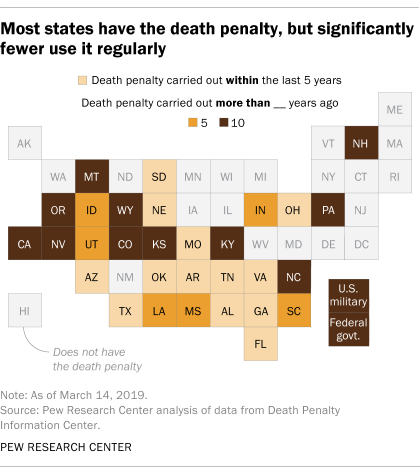The first recorded case of the death penalty inside a U.S. correctional facility dates back to 1834. Since that time, multiple states have rejected the death penalty, but some continue the practice. Throughout history, citizens, politicians, and the United States Supreme Court have weighed in on the legalities and ethics of capital punishment. Today, there are 29 states with the death penalty – although some currently have a moratorium (a temporary cessation) on executions as of 2019.
History Of The Death Penalty
Criminal executions have always happened in the U.S. and even took place in the North American colonies. In early history, however, most executions took place in a public setting as opposed to a jail or prison. In the English colonies of North America, the first recorded execution took place in 1608 when George Kendall was killed for an alleged plot to side with the Spanish against the British settlers of the New World. In 1834, Pennsylvania was the first state in the U.S. to officially require that convicted criminals sentenced to death be executed in a prison setting. Since that time, multiple states have enacted similar laws, which have taken on many forms in terms of who can be executed and how executions may be carried out. Also called capital punishment, several states have outright rejected the death penalty and have replaced it with lifetime imprisonments instead.
States with the death penalty as of 2019:
- Alabama
- Arizona
- Arkansas
- California
- Colorado
- Florida
- Georgia
- Idaho
- Indiana
- Kansas
- Kentucky
- Louisiana
- Mississippi
- Missouri
- Montana
- Nebraska
- Nevada
- N. Carolina
- Ohio
- Oklahoma
- Oregon
- Pennsylvania
- S. Carolina
- S. Dakota
- Tennessee
- Texas
- Utah
- Virginia
- Wyoming
The Federal Government and the Death Penalty
Although there are 21 states who do not practice capital punishment in 2019, it should be noted that a federal death penalty exists and can be imposed on a criminal convicted of a federal crime regardless of state law where the crime was committed. The United States military also issues the death penalty for certain crimes. The federal government has not executed a prisoner since 2003 and the last military execution happened in 1961. As of 2019, all 62 inmates awaiting execution by a federal court are currently imprisoned in Terre Haute, Indiana.
The Current State of Capital Punishment in the U.S.
Of the 29 death penalty states listed above, California, Colorado, Oregon, and Pennsylvania – the state where capital punishment originated – have all placed a moratorium on criminal executions. Those who have outright abolished capital punishment include:
- Alaska
- Connecticut
- Delaware
- Hawaii
- Illinois
- Iowa
- Maine
- Maryland
- Massachusetts
- Michigan
- Minnesota
- New Hampshire
- New Jersey
- New Mexico
- New York
- N. Dakota
- Rhode Island
- Vermont
- Washington
- W. Virginia
- Wisconsin
As of 2019, there are 2,673 people on death row in the United States. Several of these cases may be appealed and sentencing may someday be reduced. This figure also includes two inmates currently serving time on death row in New Mexico where capital punishment was repealed in 2009. Despite this fact, neither inmate received a sentence reduction and each may still face execution in the future.
With that said, more than a third of the states above haven’t carried out an execution in the last 10 years.
A Brief History Of the Supreme Court and Capital Punishment
The death penalty remains a hotly contested issue among voters, politicians, and other citizens of the United States. Capital punishment in the U.S. has been scrutinized by the Supreme Court at various points throughout history, including an outright ban on the practice imposed by the Court in 1972.
In the case of Furman v. Georgia, it was argued that the death penalty was cruel and unusual punishment and, therefore, a violation of the Eighth Amendment of the U.S. Constitution. It was further argued that the practice was often carried out arbitrarily and with bias against certain poor and disenfranchised convicts. The Court agreed with these arguments and imposed a nationwide moratorium on the death penalty which lasted statewide until 1976.
It should be noted, however, that this ruling also affected the federal death penalty, which was not reinstated until 1988. Federally, and in states where death sentences had been legal prior to this ruling, inmates condemned to death had their sentences reduced to life in prison without the possibility of parole.
The state of Georgia was largely instrumental in capital punishment being reinstated in the U.S. in 1976. This was due to Georgia revising its sentencing guidelines in such a way that the Court agreed it would no longer be considered cruel, unusual, or prejudicial when applying the death penalty. Other states, such as Florida, Louisiana, North Carolina, and Texas also adjusted their guidelines to the Court’s satisfaction and the moratorium was lifted in those states shortly thereafter. More states eventually followed leading to the aforementioned list of 29 death penalty states today.
Severity of Crimes
In 1977, the Supreme Court decided punishments must relative to crimes committed. As such, the death penalty could not be applied to cases of rape or other crimes which did not result in a victim’s death. This position was clarified by the Court once again in 2008 when it specifically stated crimes of child rape where a victim survived could not be tried as capital cases.
In 2002, the Court ruled that mentally incompetent individuals could not be executed by law. It was argued that their impairment automatically reduces the severity of any crime committed. The reasoning behind this conclusion is that a person living with such a handicap may not fully understand the harshness of their actions or reasonably intend such harm.
Following this landmark ruling, the Supreme Court also made it impossible to punish juvenile offenders with death. Similar reasoning applied as the Court deemed people under the age of 18 years lacked the maturity to fully understand the seriousness of the crimes committed. Prior to this decision, more than 350 children had been legally executed in the United States. The first recorded juvenile execution taking place as early as 1642 in the Plymouth colony located in the current state of Massachusetts.
Federal Crimes
As of 2019, in states where it is applicable, capital punishment is only allowed in cases where a person has been convicted of murder. For a federal death penalty to be applied, however, there are 41 offenses for which a convicted person may receive the death penalty. Most of these involve murder charges of varying circumstances such as violating another’s civil rights and causing their death, causing another person’s death during a hijacking, hiring someone to kill another person, murdering a witness to a crime, murder while smuggling a foreigner into the country, and murdering a law enforcement officer.
Though the list of offenses eligible for capital punishment under federal law is lengthy, within those is a shortlist of offenses that do not involve the death of another person. A person can be sentenced to death under federal law if found guilty of:
- Espionage
- Treason
- Mailing something known to cause injury with the intent to kill a recipient
Proponents vs. Opponents
Throughout history proponents of the death penalty support it for a variety of reasons including:
- A belief that the death penalty sends a message to society, which ultimately results in a reduction in violent crimes
- An eye-for-an-eye philosophy renders death as a fair punishment for severe crimes, such as murder
- Violent inmates who are killed cannot escape the prison and cause any further harm to society
- Capital punishment prevents the overpopulation of prisons
- Taxpayers should not have to pay for a violent inmate’s lifelong prison stay
Opponents of the death penalty consistently argue against its application for some of the following reasons:
- A belief that killing is immoral no matter what
- Because 160 innocent people formerly on death row have been released from prison since 1973, there is a risk of mistakenly executing other innocent citizens if capital punishment continues.
- Studies have shown that capital punishment does not deter crime
- Racial and class bias within the criminal justice system causes people of color to be executed at statistically higher-than-average rates
- Court trials, legal representation, the appeals process, special housing, length of stay, and more have been shown to cost taxpayers more for death penalty cases than lifetime imprisonment
Further Information
As long as the death penalty exists in the United States, it is sure to be a hotly contested issue. Proponents and opponents should have knowledge of the history and facts surrounding the death penalty as voting citizens. For more information on capital punishment in the U.S., please visit our article archives. Individuals with precise legal questions, who may have charges filed against them or who are in need of assistance with a capital punishment case should consult an attorney experienced in this area.

